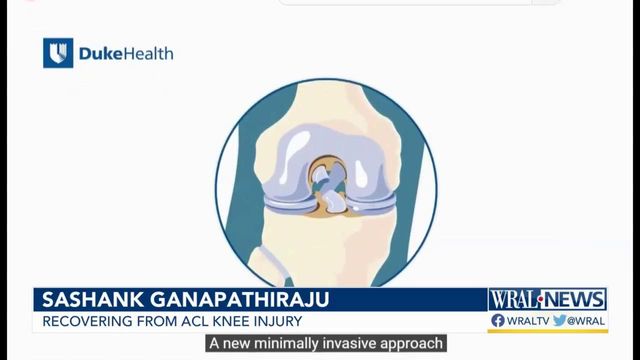Less invasive, faster recovery: Duke Health part of new ACL surgical trial
A new surgical approach is being evaluated that could help some patients recover faster and preserve more of their own tissue.
Posted — UpdatedNow, a new surgical approach is being evaluated that could help some patients recover faster and preserve more of their own tissue.
UNC student Sashank Ganapathiraju enjoys intramural basketball, but hasn’t played since last August 2022.
"That’s when my knee just gave way. This pain was like instant and it was the worst pain I’ve ever experienced in my life," he said.
At first, standard ACL surgery seemed to be the only answer; however, Ganapathiraju learned about a less invasive approach through a trial at Duke Health.
It’s called BEAR, an acronym for "Bridge Enhanced ACL Repair." Duke orthopedic surgeon Dr. Brian Lau says the procedure takes advantage of your body’s natural healing capabilities instead of relying on grafted tissue.
He says this surgery is not for everyone, however.
"So you have to have good residual ACL tissue left and I’d say that’s the minority of ACL tears," he said.
Through small incisions, the torn ends of the ACL are stitched together to stabilize the knee. Unlike standard ACL surgery, this approach does not drill into bone or take grafts from body tissue like ligaments and tendons.
"A small amount of your own blood is added to the B.E.A.R. implant which is placed into the knee," said Lau.
He says the approach aims to preserve receptors on the nerve endings in order to improve healing.
"That’s a major benefit of doing ACL repair, is that being able to preserve their own tissue," said Lau.
"The prospect of having an implant here rather than taking your graft from a different part of my leg kind of intrigued me," said Ganapathiraju.
Two days after the surgery, he says he felt no pain, but played it safe on crutches.
"That was my first indication that, hey, this is actually kind of working," said Gunnapathiraju.
Five months later, he’s walking around campus and even jogging. He is eager to get back on the basketball court when Lau gives the OK.
Lau said, "You know, sports and returning to sports is a big part of, you know, our society and our culture."
He says he hopes to make the procedure even less invasive for younger patients who’s bones are still growing.
Related Topics
• Credits
Copyright 2024 by Capitol Broadcasting Company. All rights reserved. This material may not be published, broadcast, rewritten or redistributed.





